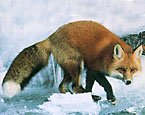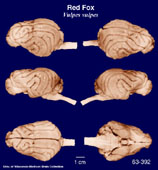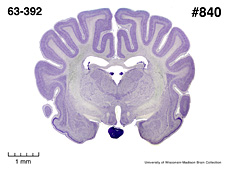|
Red
Fox
(Vulpes vulpes) #63-392 |
||||
|
|
Physical
characteristics and distribution
|
|
Red Foxes are most commonly a rusty red, with white underbelly, black ear tips and legs, and a bushy tail with a distinctive white tip. The "red" tone can vary from crimson to golden, and in fact can be brindled or agouti, with bands of red, brown, black and white on each individual hair when seen close up. In the wild, two other color phases are also seen. The first is silver or black, silver foxes, comprising 10% of the wild population and most of the farmed. Approximately 30% of wild individuals have additional black patterning, which usually manifests as a stripe across the shoulders and down the center of the back. This pattern forms a "cross" over the shoulders, hence the term "cross fox". "Domesticated" or farmed stock may be almost any color, including spotted, or "marbled", varieties. All foxes are relatively small. Red foxes may reach an adult weight of 3.6 - 7.6 kgs (7.9 - 17 lbs). All are opportunistic foragers, eating live animals (mammals, birds, amphibians, reptiles, fish and various invertebrates (insects and worms). Where available, they also eat berries and other forms of plant material. Most foxes capture live prey using a characteristic leap, pounce with vertical descent from a distance of even several feet. When landing, the forepaws and nose poke directly into the snow and ground surface. The Red Fox's breeding period varies widely due to its broad distribution; southern populations breed from December to January, central populations from January to February and northern populations from February to April. Females have an annual estrous period of between 16 days; ovulation is spontaneous. Males will supply food to females up to and after birthing, otherwise leaving the female alone with her kits (also called cubs or pups) in a "maternity den". An average litter size is 5 kits, but may be as large as 13. Kits are born blind and may weigh as much as 150 grams (0.33 pounds). Their eyes are open by two weeks and the kits have taken their first exploratory steps out of the den by five weeks; by 10 weeks they are fully weaned. Although somewhat social, foxes commonly hunt in solitary manner. They breed once each year and several young are born in a den or burrow. Foxes are mainly monogamous, but communal denning is known to exist . Foxes scent mark their territories. Foxes bark, yap and howl to some extent. There are numerous species and they vary in size, occupying all continents and climates. Red Foxes can be found in Afghanistan, Albania, Algeria, Armenia, Austria, Azerbaijan, Bangladesh, Belarus, Belgium, Bhutan, Bosnia and Herzegovina, Bulgaria, China, Croatia, Czech Rep., Denmark, Egypt, Estonia, Finland, France, Georgia, Germany, Great Britain, Greece, Hungary, Iceland, India, Iran, Iraq, Ireland, Israel, Italy, Japan, Jordan, Kazakhstan, Krygyzstan, Laos, Latvia, Lithuania, Macedonia, Moldova, Mongolia, Morocco, Nepal, Netherlands, North and South Korea, Norway, Pakistan, Portugal, Romania, Russia, Serbia and Montenegro, Slovakia, Slovenia, Spain, Sweden, Switzerland, Syria, Tunisia, Turkey, Turkmenistan, Ukraine, USA (Alaska, throughout most of the contiguous 48 states except central plains and SW deserts), Uzbekistan, Vietnam and introcuced to Australia. |
|
Description
of the brain
|
|
Animal
source and preparation
|
|
Our Red fox was obtained from a Wisconsin trapper. All specimens collected followed the same preparation and histological procedure. |
Other Related Resources (websites and publications)
List of Specimens | Explore Collections | Brain Sections | Brain Evolution | Brain Development | Brain Circuitry | Brain Functions | Location and Use | Related Web Sites | Contact Us | Search MSU Database | Personnel | Home



